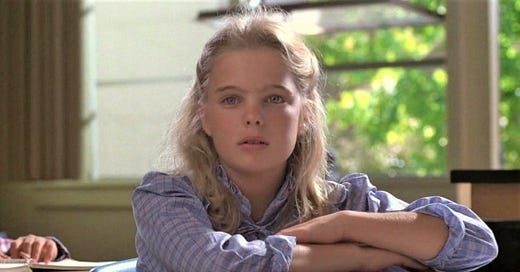General overview
This segment of the movie begins in a classroom, where a teacher strolls down the aisle, pausing to examine a drawing of E.T. by Elliot. Dismissing it, he proceeds with the lesson. Shifting to Elliot’s home, E.T.’s silhouette emerges from Elliot’s room. Back in the classroom, a brief shot focuses on Elliot, while E.T. explores the fridge, tasting potato salad before discarding it and reaches for a beer, to the disapproval of the barking dog. E.T. gulps down the drink as Elliot unexpectedly burps in class. In the kitchen, E.T. collides with a cabinet then we see Elliot’s subsequent head-rubbing. Another shot contains E.T. slipping on the floor, mirroring with Elliot’s chair slide. E.T. opens another beer, while Elliot shares a tipsy smile with a girl behind him. Moving to the living room, E.T. chuckles at a cartoon on TV, absorbing his surroundings like a child. Meanwhile, the teacher places chloroform balls in frog jars, making Elliot to release them, reminded of E.T.’s innocence. E.T. discovers a comic depicting a man communicating via transmitter, then watches a family making long-distance calls on TV. Elliot quietly urges, “Save him,” before freeing the frogs. E.T. observes a spelling toy, while the classroom becomes overrun with frogs. As E.T. watches a heroic scene on TV, Elliot unconsciously mimics it with the girl from earlier. The parallel editing ends with a shot from the girl’s perspective, starting from her shoes and panning up to Elliot being escorted away by the teacher.
Cinematography
The scene begins in Elliot’s classroom, with the camera tracking the teacher as he walks down the centre of the desks. Shot from waist height to match the children’s eye level, this perspective offers the audience a childlike viewpoint of the film.
Object glance shots are used to help the audience in understanding what E.T. is observing. We witness his gaze directed towards something, followed by a shot revealing the object of his attention. This technique increases the audience’s understanding of the narrative.
We observe from a low angle as the girl witnesses Elliot being led away by the teacher. Positioned in the foreground of the frame, with Elliot centrally located but farther away, it’s evident that the girl’s focus is on Elliot. As a nod to “The Wizard of Oz,” her right foot subtly turns inward in the shot.
Mise-en-scène
E.T. emerges from Elliot’s bedroom, bathed in a chilly blue glow similar to the one in the opening sequence where Elliot encounters the blue light shining from the shed.
The scene transitions to the teacher placing chloroform balls into jars housing frogs. Elliot lowers himself to inspect his frog closely, a sight that triggers memories of E.T.
We witness E.T. observing various items around the house, each visually significant and hinting at future events. For instance, the comic book E.T. reads depicts someone isolated on a planet, reaching out to others via a transmitter. Furthermore, he watches a TV show where a family communicates with distant relatives over the telephone. Following this, a reaction shot signifies that an idea has sparked in E.T.’s mind, as he gazes down at the phone.
Sound
Throughout the scene, dialogue is the exposition. For example, the classroom scene opens with Elliot’s teacher detailing the task they are about to undertake.
A non-diegetic composed score starts playing as the camera focuses on the frog trapped in the jar, serving to emphasise to the audience that Elliot is thinking about E.T.
A sound bridge seamlessly carries the sound from E.T.’s television into the next shot of Elliot in the classroom. An L-cut transitions the diegetic score from the TV into a non-diegetic score during Elliot’s interaction with the girl, effectively linking the two scenes together and concluding the parallel editing.
Editing
The film mainly uses continuity editing, aiming to ensure that the target audience can easily follow and understand the storyline.
Parallel editing serves a deliberate purpose in helping the audience’s understanding of the story. E.T. and Elliot’s physical connection is highlighted through this technique, effectively conveying to the audience that E.T.’s actions have an impact on Elliot.
The initial parallel moment unravels as E.T. discovers and drinks a can of beer from the fridge, followed by a scene in the classroom where Elliot unexpectedly burps. E.T. opens another beer making Elliot to smile drunkenly and make him feel overconfident. As E.T. starts to feel the effects of being drunk, he accidentally hits his head on a cupboard. In a parallel experience, Elliot suddenly feels the pain in his own head, mirroring E.T.’s pain. In addition, E.T. falls onto the floor, followed by Elliot sliding off his chair in sync. He gazes at a comic book featuring a transmitter sending an SOS message. Elliot experiences a similar feeling but in a different manner, feeling compelled to free the frogs. E.T. watches a heroic sequence on TV, making Elliot to mimic the actions in real life, particularly with a girl in his class.
Science-Fiction Genre Conventions
Not many genre conventions are conveyed in this sequence of the film. Slight hints of the 'cosy-catastrophe' and a blend of familiar yet distinct settings are present. This is evident as we observe E.T. in Elliot’s beloved and realistic home. The juxtaposition between the two creates a sense of familiarity with a unique twist, which later increases our empathy as government authorities invade Elliot’s home.
Moreover, in this scene, Elliot represents one of Vladimir Propp’s hero types as the central focus of the film. This is evident as Elliot courageously releases the frogs, portraying the brave hero stereotype as he fights for what he believes is right. Similarly, the conventional trope of the hero winning the affection of the princess is also used.




